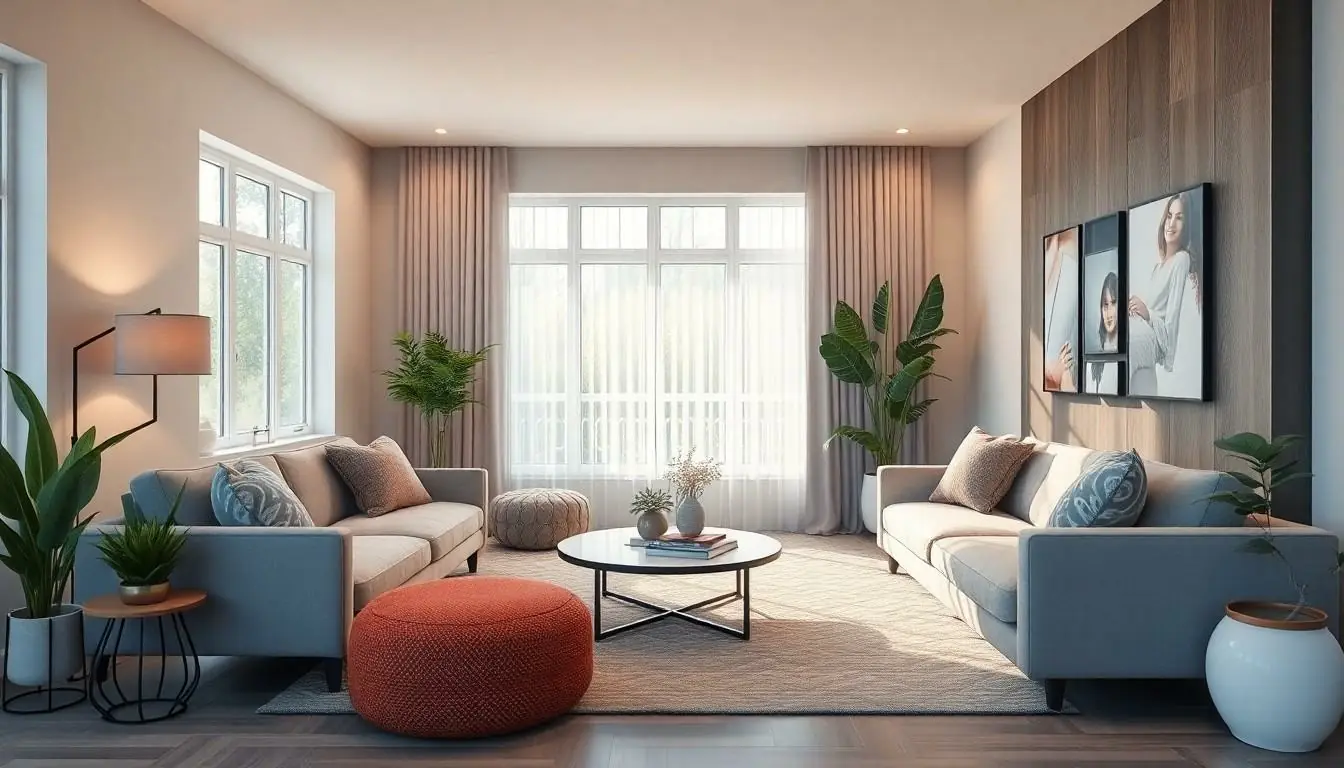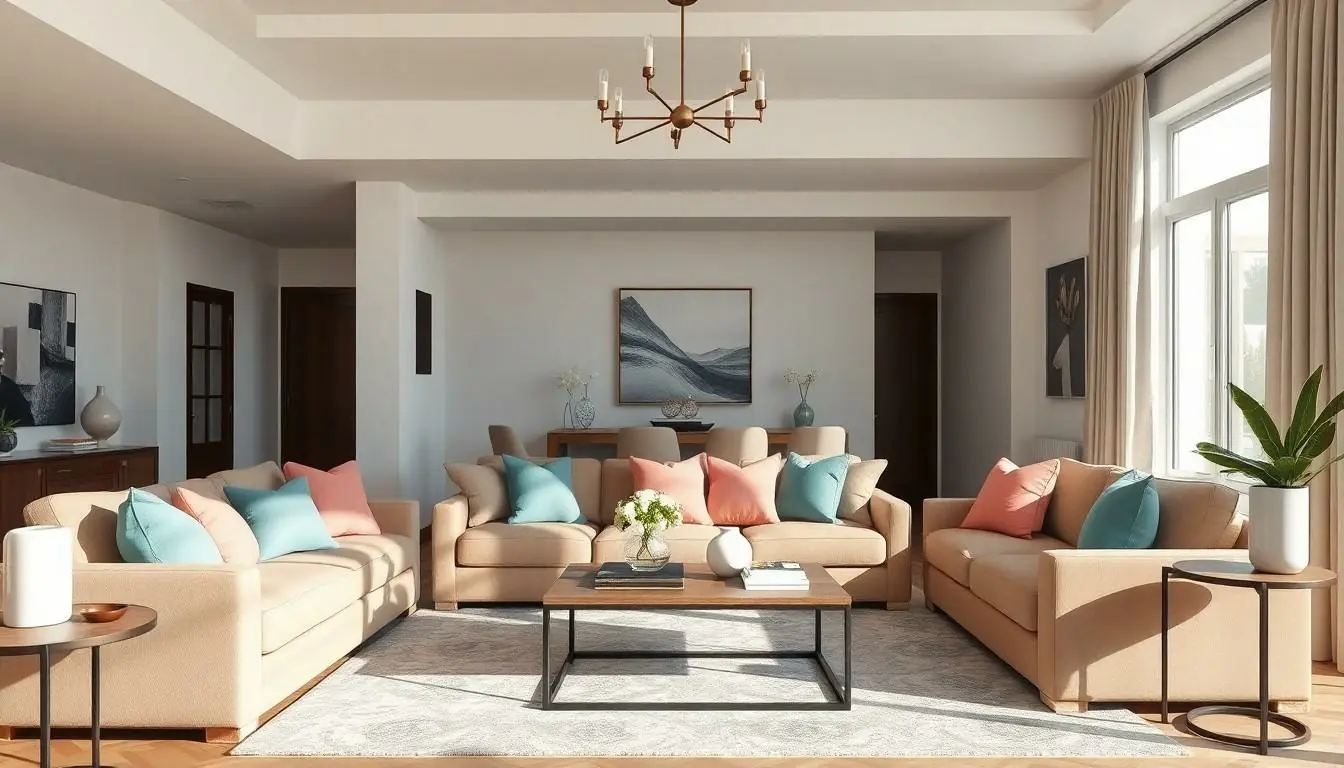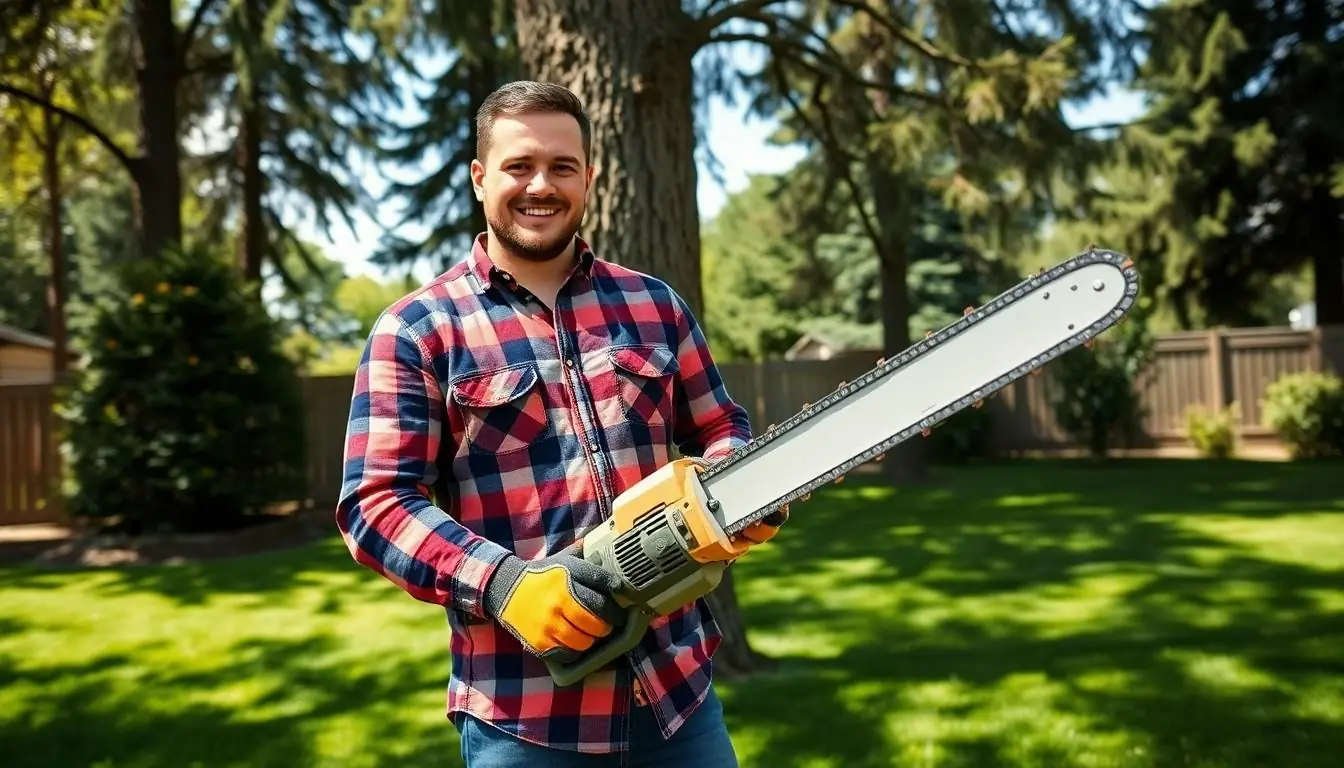In a world where first impressions matter, interior design photos are the secret sauce that can transform any space from drab to fab. They’re not just pretty pictures; they’re the visual storytellers that breathe life into walls and whisper sweet nothings to furniture. Whether it’s a cozy nook or a sprawling living room, the right photo can make anyone feel like they’ve just stepped into a Pinterest board come to life.
Table of Contents
ToggleImportance of Interior Design Photos
Interior design photos play a crucial role in shaping perceptions about spaces. These images communicate design choices effectively and evoke emotions, contributing to a space’s overall impact.
Visual Storytelling in Design
Visual storytelling becomes a powerful tool in interior design. Each photo provides insights into a designer’s vision and thought process. Spaces come alive through well-composed images, transforming simple decor into engaging narratives. Influential designers capture the essence of comfort, elegance, or modernity in their photos. Every corner tells a story, inviting viewers to envision their experiences within that space.
Enhancing Aesthetic Appeal
Aesthetic appeal significantly improves when high-quality interior design photos are utilized. Striking images attract attention and encourage engagement across various platforms. Beautifully styled spaces encourage potential clients or buyers to imagine how the designs could look in their environments. Every aspect, from lighting to color schemes, contributes to the visual experience. Studies show that visually appealing images increase interest and leads by up to 80%, showcasing their undeniable importance in design marketing.
Types of Interior Design Photos

Interior design photos come in various styles, each serving a unique purpose and audience. Understanding these types helps in selecting the right images to maximize engagement.
Residential Design Photos
Residential design photos capture living spaces like homes and apartments. These images highlight features such as furniture arrangement and color palettes, showcasing styles from modern to traditional. A well-curated collection can evoke feelings of warmth, inviting viewers to imagine their own lives in those spaces. These photos often focus on areas like kitchens, living rooms, and bedrooms, emphasizing comfort and personalization. Quality images from skilled photographers present intricate details, making spaces feel accessible and desirable. According to studies, 80% of potential buyers express increased interest due to appealing residential images.
Commercial Design Photos
Commercial design photos serve businesses and professional spaces. These images showcase environments like offices, retail shops, and restaurants, aimed at attracting customers or clients. Highlighting functionality and aesthetic appeal, commercial photos depict branding through design elements. Key areas include reception areas, workspaces, and dining sections, emphasizing efficiency and atmosphere. High-quality visuals can convey professionalism and innovation, guiding business decisions. Engaging images not only draw attention but also enhance brand perception, making them crucial for marketing strategies. Studies indicate that effective visual communication increases customer traffic by as much as 70%.
Techniques for Capturing Great Interior Design Photos
Capturing great interior design photos involves mastering various techniques that enhance visual storytelling and appeal. Effective lighting and composition play crucial roles in these processes.
Lighting and Composition
Natural light creates inviting atmospheres. Aim to shoot during golden hours—shortly after sunrise or before sunset—for soft, warm illumination. Incorporating multiple light sources brightens spaces while mitigating harsh shadows. Position furniture strategically to highlight focal points, ensuring a balanced composition guides viewers’ eyes. Consider using leading lines, like hallways or furniture arrangements, to draw attention to key areas. Utilizing wide-angle lenses can capture more space without distortion, providing a sense of openness. Experimenting with various angles, such as eye level or slightly elevated, can give unique perspectives on interior layouts.
Post-Processing Tips
Enhancing photos through post-processing can elevate their overall quality. Begin with adjustments in brightness and contrast to make images pop. Use cropping tools to eliminate distractions and emphasize focal points. Applying a slight vignette can draw the viewer’s attention toward the center of the photo. Color correction tools help maintain accuracy, ensuring hues reflect the actual interior design. Adding subtle sharpness enhances details without introducing noise. Lastly, maintain a consistent style across images, as this cohesive look appeals to potential clients.
Platforms for Sharing Interior Design Photos
Interior design photos thrive on various platforms, enhancing visibility and engagement. These platforms offer unique ways for designers to showcase their work and connect with potential clients.
Social Media Influence
Instagram, Pinterest, and Facebook serve as powerful tools for sharing interior design photos. Visual-centric platforms like Instagram, with its 1 billion monthly active users, enhance engagement through stunning imagery. Pinterest attracts 400 million monthly users actively seeking design inspiration. Facebook provides community-building opportunities through groups dedicated to design enthusiasts. Each platform enables designers to tap into niche markets while showcasing styles that resonate with target audiences. The shareability factor on these networks can dramatically increase exposure and generate leads, underscoring the importance of visually appealing content.
Online Portfolios and Websites
Creating an online portfolio or website allows designers to present curated collections of their work. Platforms such as Squarespace, Wix, and WordPress enable designers to customize their sites, showcasing their best interior design photos. High-quality images displayed in a professional format can reflect brand identity and attract potential clients. SEO optimization enhances visibility, helping design portfolios appear in search results. Client testimonials and project descriptions further enrich the user experience, driving inquiries and conversions. Utilizing an online presence maximizes reach while establishing credibility in the competitive design industry.
Interior design photos play a pivotal role in shaping perceptions and creating lasting impressions. They’re not just images; they’re powerful tools that tell stories and evoke emotions. By mastering the art of visual storytelling, designers can turn simple decor into engaging narratives that resonate with viewers.
Whether showcasing residential warmth or commercial functionality, high-quality images significantly enhance engagement and attract potential clients. With the right techniques and platforms, designers can elevate their work, ensuring it stands out in a crowded market. The impact of striking visuals on interest and leads cannot be overstated, making interior design photography an essential element in any successful marketing strategy.



